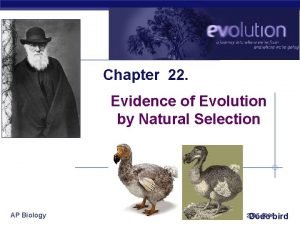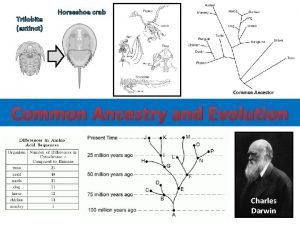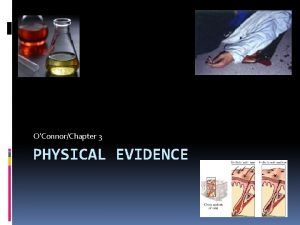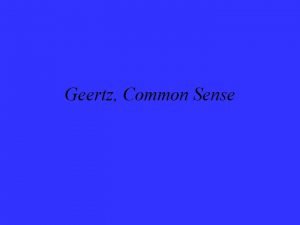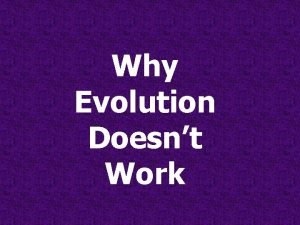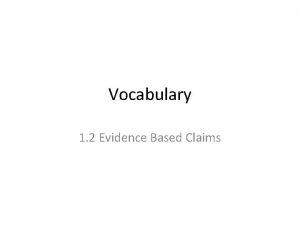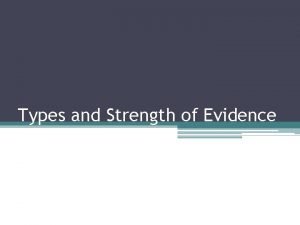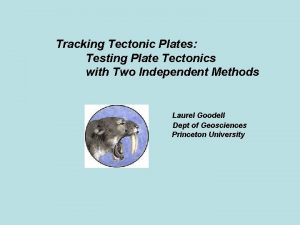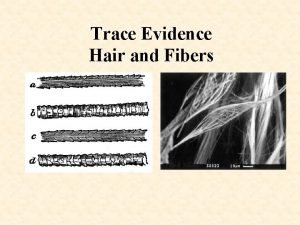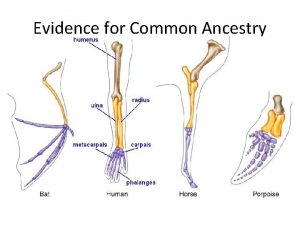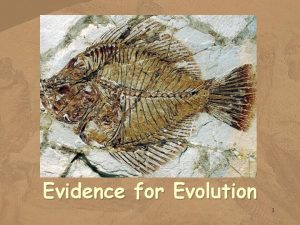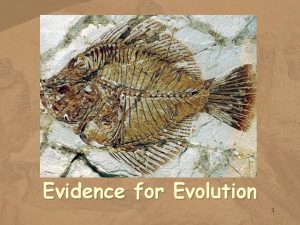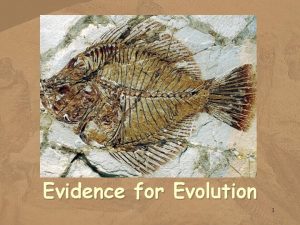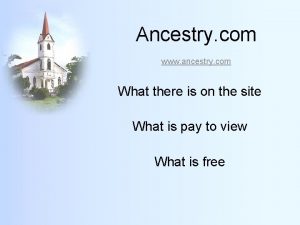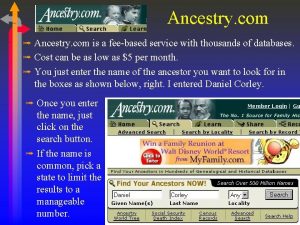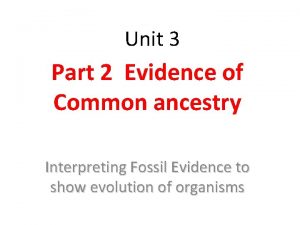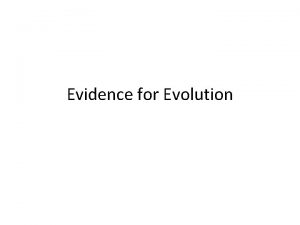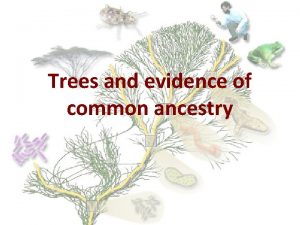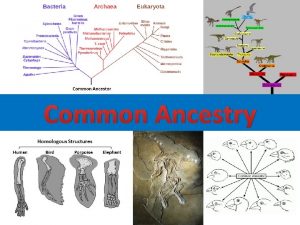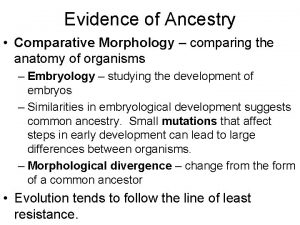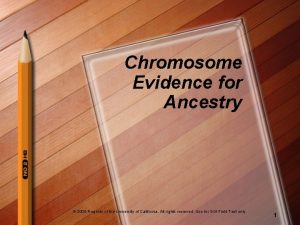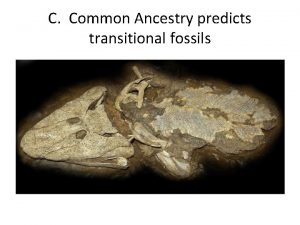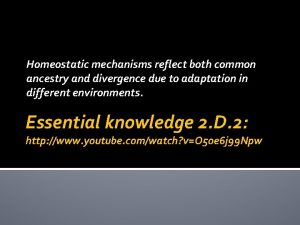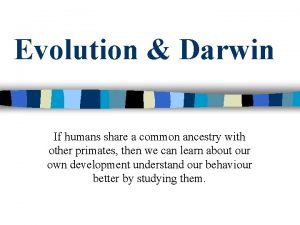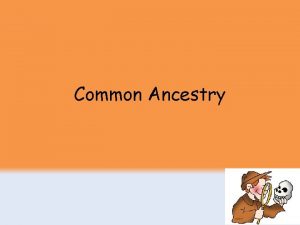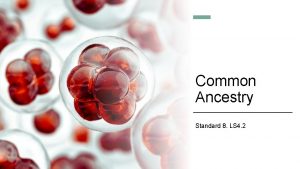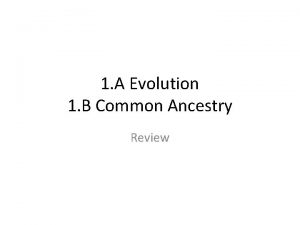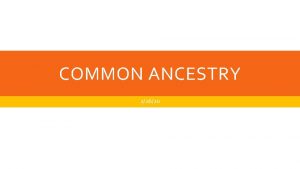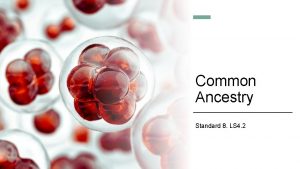7 A Evidence of Common Ancestry Summary of








































- Slides: 40

7 A Evidence of Common Ancestry

Summary of Darwin’s Theory Individuals with the VARIATIONS/ ADAPTATION best-suited to their environment will survive and reproduce. Those not suited will be less likely to breed (Survival of the fittest!)

Summary of Darwin’s Theory Species change over time, by passing on their useful (and harmful? ) traits to their offspring

Summary of Darwin’s Theory THEREFORE, All species alive today have therefore descended with modifications from ancient ancestors

Summary of Darwin’s Theory Ultimately, ALL organisms on Earth are united into a single tree of life… Darwin’s original sketchbook drawing



This is…. Common Ancestry – the concept that a group of closely related species are all descended with some modifications from the same ancestor Descent with modification –idea that living species have descended with changes due to adaptations and natural selection from species that lived before them


Evidence of Evolution #1: Fossil Record Fossils – preserved remains or traces of ancient organisms evidence that the world was much older than once thought Fossils show organisms have changed over time ? ? ? w o kn u o y Did 99% of species that once lived are now extinct!!!

The Geological Timescale Based on fossil evidence, it appears that the nature and diversity of life on our planet has changed dramatically throughout Earth’s history

Fossil Record When comparing fossils found in rock layers, the deeper the layer, the older the fossil.

Index Fossil – fossils of species that are easily recognizable, that lived during a specific geological time period, with a wide geographic range Are used to determine age of other fossils by comparing.

Evidence of Evolution #2: Biogeography Beaver Biogeography ► The study of where species live now and where species and their ancestors lived in the past. Beaver Muskrat ► Shows common ancestry two ways: 1. Provide evidence as to how closely related species change in different environments/selection pressures 2. How distantly related groups have evolved similar traits under similar selection pressures Capybara Beaver and Muskrat Coypu Capybara Coypu and Capybara Coypu

Evidence of Common Ancestry #3: Homology • Homology is the study of similar characteristics between organisms • There are three major branches of homology: 1. Anatomical Homology 2. Embryological Homology 3. Molecular Homology

Anatomical Homology Homologous Structures - Same structure, different function - Same ancestor, different function On first appearance, would you say that a human hand, a bat’s wing and a whale’s flipper were the same structure?

Beneath The Surface… Homologous Structures –Same structure different function

Evidence of Evolution Analogous Structures: structures similar in function, but not inherited from a common ancestor. • Same function, different structure • different ancestor Flight Protection

Analogous structures have the same function but evolved from different places. -Analogous structures are also evidence for evolution because they show that two organisms that came from different ancestors, when placed under the same environmental pressures can evolve the same adaptations.

Vestigial Structures that are inherited, but reduced in size and not used anymore Whale pelvic bone Human tailbone Human appendix

Embryological Homology • Embryology - the study of developing animals in its earliest stages • Embryos give evidence for evolution because many different kinds of organisms have embryos that look alike, suggesting that they all evolved from a common ancestor. The diagram below shows embryos of five different species: pig, chicken, fish, turtle, and human. Can you tell which is which?

Figured it out yet?

How about now?

Did you guess correctly?

Chicken – 2 ½ days Human – 31 days Pig – 21 days

Human – 9 weeks Pig – 30 days Lemur – 3 ½ weeks

Human face – 5 weeks

Pig – 30 days Human – 6 weeks Macaque monkey – 4 weeks

Limb Buds Pig foot – 30 days Human hand – 6 weeks Chicken foot – 5 days


Human – 16 weeks Chimpanzee – 18 weeks

Macaque monkey – 10 weeks


Human Embryo Development Time Lapse Animation: Click here for a time lapse animation. 4 weeks

Molecular Homology • All living things contain DNA and RNA. • Changes in Proteins, DNA and RNA can be traced from ancestors to their descendents. • The fewer differences there are between these molecules in different organisms, the more closely related they are Apple Protein Celery Protein

DNA of Chimpanzee, Human, & Chicken Note – there are more differences between the human and chicken than the human and chimp With which organism do we share a more recent common ancestor?

Chromosome 1 of different species

Chromosome Homology Chromosome comparison of human, chimpanzee, gorilla, and orangutan

Human & Chimpanzee Chromosomes • Human on the left • Chimp on the right • Notice that Human Chromosome #2 appears to be a combination of Chimp Chromosomes #2 & 3

Checkpoint The table below demonstrates the amount of DNA overlap that five animals have with the DNA of a chimpanzee. Animal DNA % Overlap with Chimpanzee Dog 54% Cat 47% Gorilla 87% Human 97% Giraffe 68% Order the Animals From More Closely Related to Least Closely Related in their ancestral relationship with chimpanzees.
 Inecible
Inecible Natural
Natural Ancestry dna sverige
Ancestry dna sverige Hakka ancestry
Hakka ancestry Diana spencer family tree
Diana spencer family tree Horseshoe crab trilobite
Horseshoe crab trilobite Ashanti ancestry
Ashanti ancestry Wide nose
Wide nose What is primary sources
What is primary sources Primary evidence vs secondary evidence
Primary evidence vs secondary evidence Primary evidence vs secondary evidence
Primary evidence vs secondary evidence Primary evidence vs secondary evidence
Primary evidence vs secondary evidence Primary evidence vs secondary evidence
Primary evidence vs secondary evidence How can class evidence have probative value
How can class evidence have probative value Class vs individual evidence
Class vs individual evidence Individual evidence can have probative value.
Individual evidence can have probative value. Class evidence vs individual evidence
Class evidence vs individual evidence The absence of evidence is not evidence of absence meaning
The absence of evidence is not evidence of absence meaning What is the greatest value of class physical evidence
What is the greatest value of class physical evidence Slidetodoc.com
Slidetodoc.com Factors 0f 18
Factors 0f 18 Common anode and common cathode
Common anode and common cathode Gcf of 48 56 and 72
Gcf of 48 56 and 72 What are the factors for 54
What are the factors for 54 What is the least common multiple of 18 and 27
What is the least common multiple of 18 and 27 Highest common factors and lowest common multiples
Highest common factors and lowest common multiples Johns hopkins ebp model
Johns hopkins ebp model Common sense as a cultural system
Common sense as a cultural system What is a analytical paragraph
What is a analytical paragraph Analysis sentence starters
Analysis sentence starters Evidence of evolution
Evidence of evolution What is impression evidence
What is impression evidence What comes into your mind when you hear the word history
What comes into your mind when you hear the word history Dreaded textual evidence
Dreaded textual evidence Claim noun
Claim noun Evidence for evolution doodle notes
Evidence for evolution doodle notes Vbr recruitment
Vbr recruitment Ad hominem
Ad hominem Analogical evidence example
Analogical evidence example Evidence of the theory of plate tectonics
Evidence of the theory of plate tectonics Hair and fiber evidence
Hair and fiber evidence

